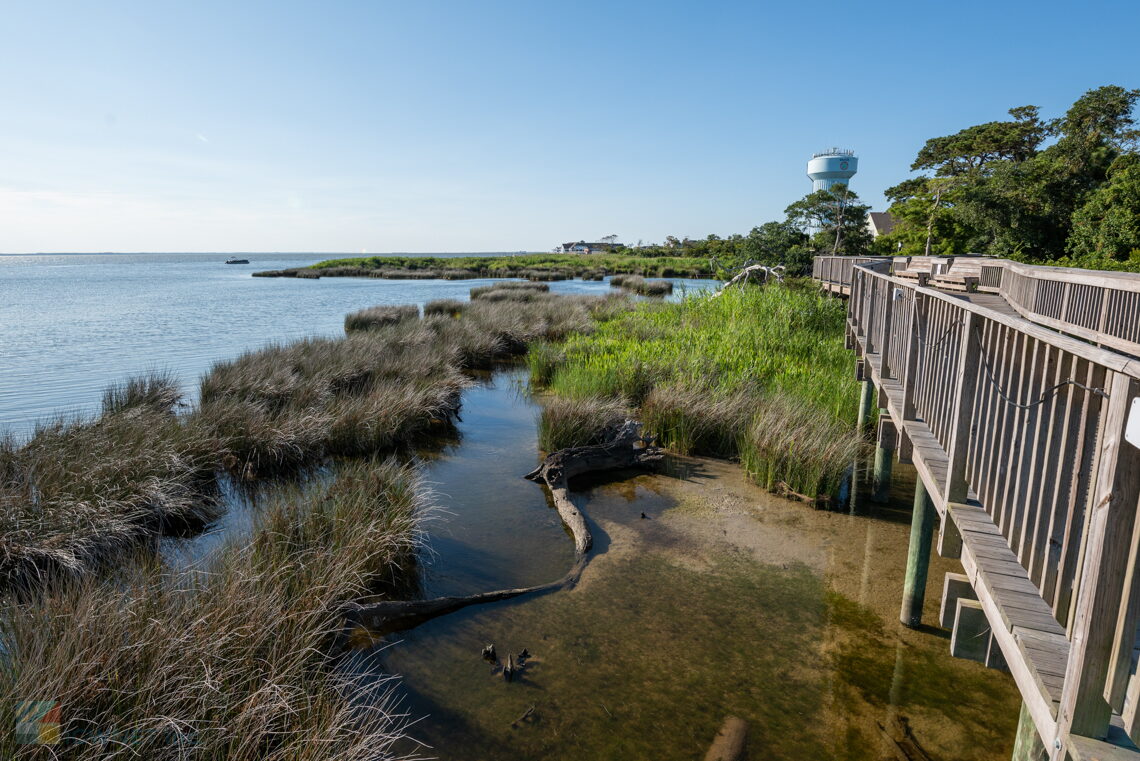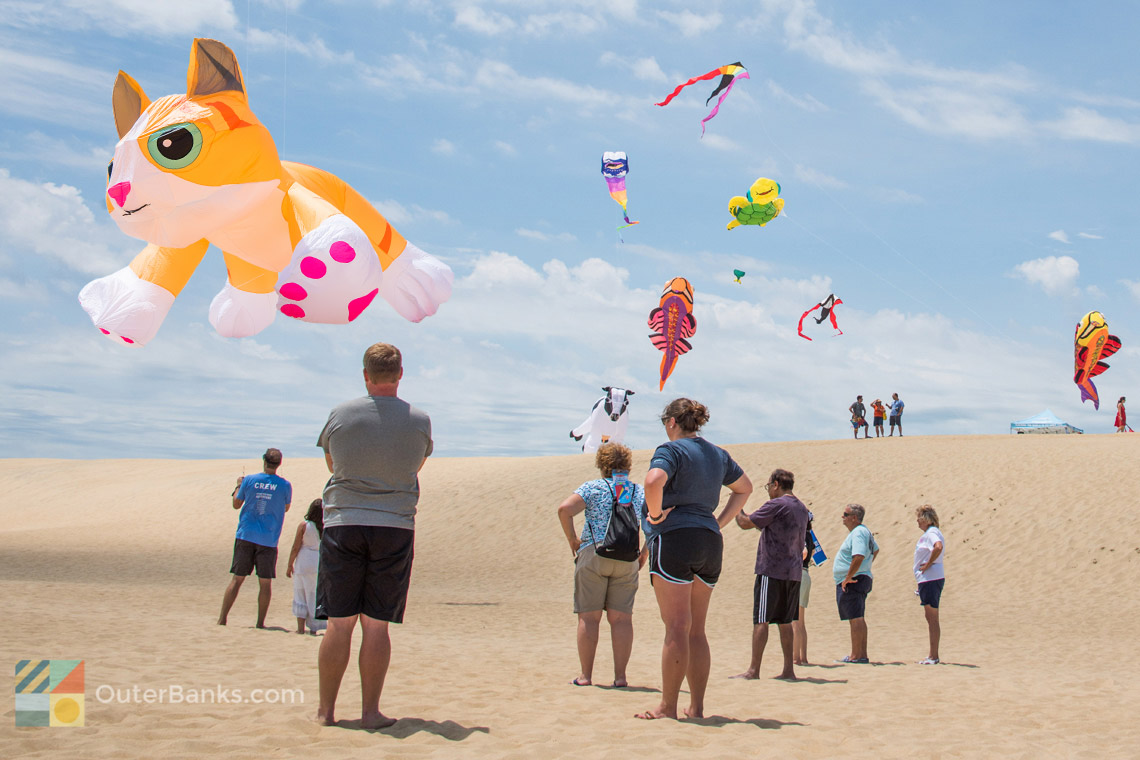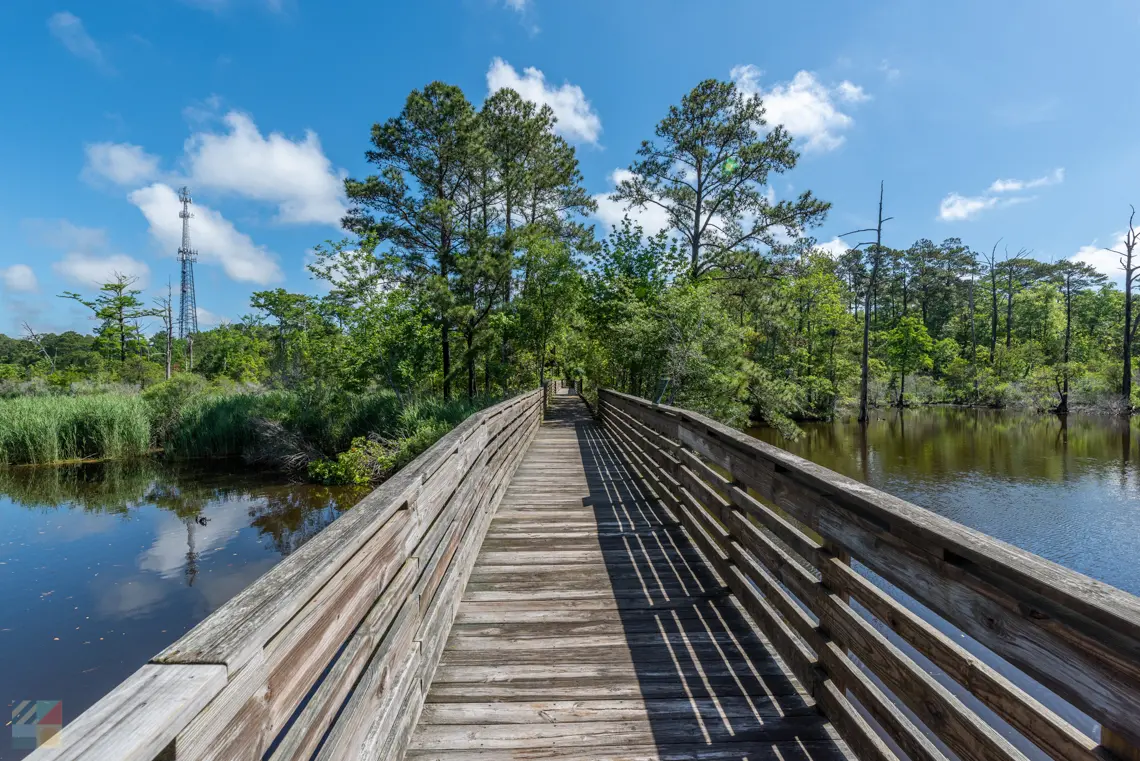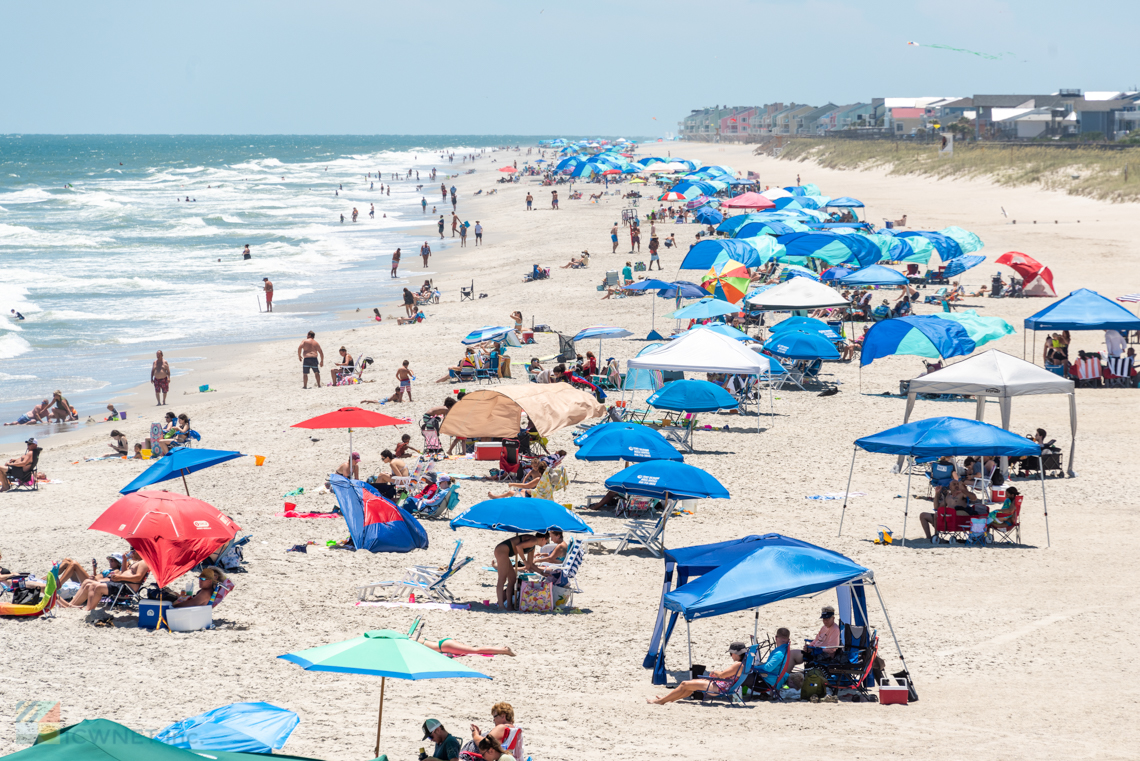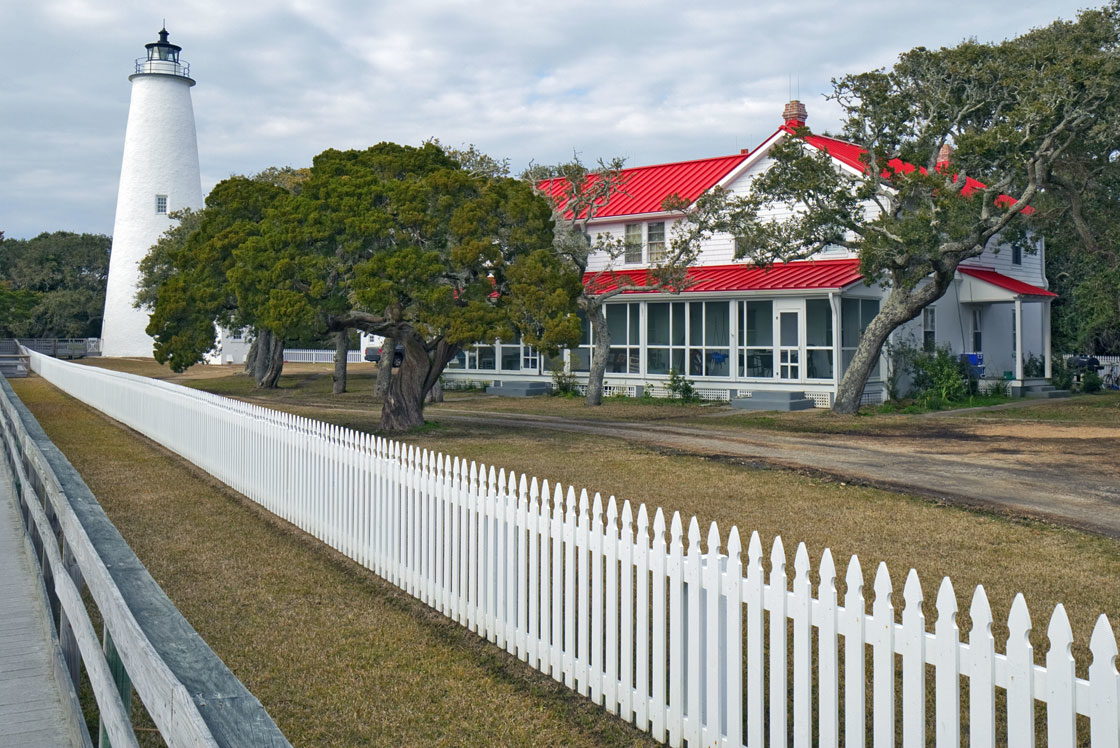The Currituck Sound is a nature lover's playground, offering ample access to wide open spaces of shallow, easy to navigate open water, dense thickets of maritime forest, and small, marshy islands that are covered in wildlife.
There's a reason why some of the Outer Banks' earliest visitors flocked first to the northern beaches of Duck and Corolla. With miles of soundfront providing a comfortable but temporary home to thousands of migrating waterfowl, the landscape proved ideal for adventurous hunters, and provided a gorgeous and wild vacation destination for explorers who liked to escape to a locale well off the beaten path.

Today, the Currituck Sound is just as wild as it was 100 years ago, with miles of terrain to explore from Southern Shores to the Virginia border, and plenty of locally owned companies that are happy to give newcomers a guiding hand. On your next Outer Banks vacation, grab a kayak, a skiff, or a sturdy pair of flip flops, and embark on your own Currituck Sound explorations. With some of the most wildly beautiful vistas on the northern Outer Banks, (also known as the Currituck Banks), a visit to the Currituck Sound is an ideal way to get your feet wet in the local wildlife scene.

History of the Currituck Sound
Well before thousands of vacationers headed to the Outer Banks for a fantastic vacation, the Currituck Sound was one of the few attractions for out-of-state visitors along the coast of North Carolina. The area was well-known among high class New England and New York aristocrats as a fantastic location for adventurous duck hunting and fishing, and rustic but exquisitely regal hunt clubs popped up along the Northern Outer Banks well before the rest of the Outer Banks were receiving frequent vacationers.
In fact, by the 1920s, one such club, the Whalehead in Historic Corolla, was already gaining national recognition as one of the most distinguished wilderness retreats ever built, a distinction that carries on today as the Whalehead in Historic Corolla is still open to awed visitors who marvel at its grandeur, its rows of rooftop windows, and its light lemon yellow exterior (a replication of the original color.)
The reason for this fantastic hunting and fishing was simple. The Currituck Sound bordered, (and still does), acres of undisturbed marshlands, maritime forests, and undisrupted landscape where wildlife could flourish.

In addition, this sound was one of the few sounds along the East Coast that wasn't primarily a saltwater environment. As the inlets bordering the central Outer Banks closed up during the past few centuries, the salinity of the Currituck Sound dwindled. In fact, since the late 1700s, the only connection this sound has with the ocean is via the Oregon Inlet, located a good 40 miles south of Corolla. Because of this distinction, a number of species that aren't normally accustomed to a salty environment were able to thrive, enticing fishermen and hunters even more.
In the ensuing decades since the heyday of the 1920s hunt clubs, Corolla and the Outer Banks areas bordering the Currituck Sound, (specifically Duck and Southern Shores), enjoyed a slow expansion of tourism, mainly originating from those early legendary fishing and hunting expeditions which were still circulated stories among the northeast upper class.
This all changed in the 1970s and 1980s when NC Highway 12 was paved, and provided a viable means of transportation from the central Outer Banks all the way to the northern borders of the Currituck Banks. Soon, the northern Outer Banks as well as the borders of the Currituck Sound experienced a rush of visitors eager to discover the uncrowded beaches and natural wildlife that had drawn visitors half a century ago.
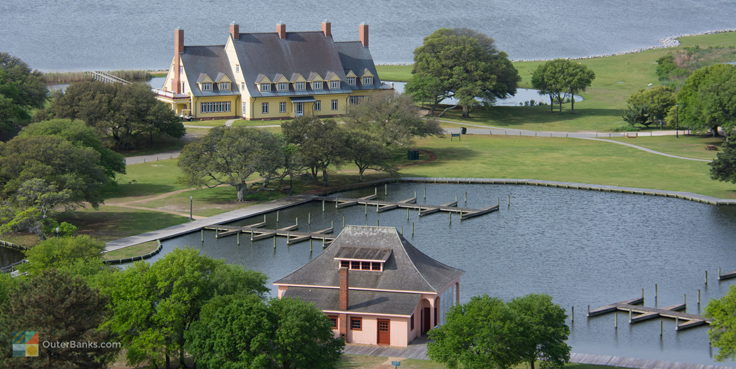
As a result of this boost in tourism, portions of Corolla and Carova bordering the Currituck Sound were sectioned off to ensure that soundfront regions would never be developed and would remain a safe haven for migrating waterfowl, as well as the regular species who called this delicate, partially-saltwater environment home. These parcels included the Currituck Banks National Estuarine Preserve, the Currituck National Wildlife Refuge, and the Mackey's Island National Wildlife Refuge, which is one of the largest areas of land in the Currituck Sound, located in between the North Carolina mainland and the Currituck Banks.
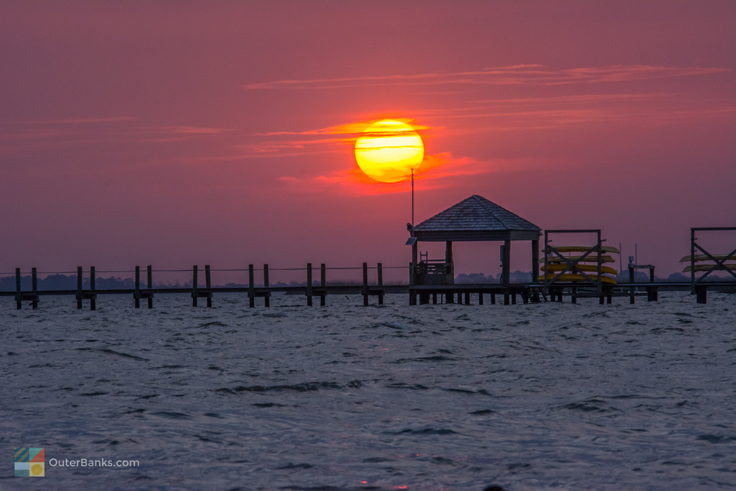
All of these land grants and designations took place in the early to mid-1980s, and as a result, portions of soundfront facing landscape remained, and still remain, undeveloped. In fact, plans were originally made to expand NC Highway 12 from Carova and the surrounding 4WD accessible villages all the way north to the Virginia border, but because of these natural reserves created to preserve the fragile Currituck Sound and beach environments, those plans were subsequently scrapped, and even today, visitors still cannot visit those areas without a 4WD vehicle and a long trek along the sandy beach.
In recent years, the Currituck Sound, which has always been known as peaceful retreat, has garnered a little controversy as plans have been debated for a "Mid-Currituck Bridge" which would span across the Currituck Sound from the North Carolina mainland to the northern Outer Banks.
The proposed 7 mile long toll bridge would begin in the community of Aydlett, and would deposit visitors just south of Corolla, providing easy access to all northern Outer Banks beach towns, including Corolla, Carova, Duck and even Southern Shores.
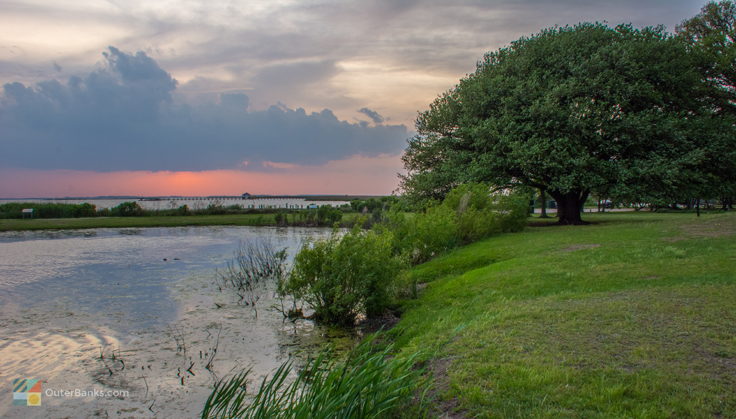
The concept for the Mid-Currituck Bridge stemmed from a rise in tourism in the 1990s and 2000s. As more visitors flocked to the northern beaches, the two-lane NC Highway 12 experienced regular weekend back-ups, with the trip from mainland Currituck around the Currituck Sound to the neighboring beaches taking anywhere from 30 minutes to an hour or more.
Opponents to the Mid-Currituck Bridge worry that the bridge will lead to a greater influx of tourism and development, spoiling the natural landscape that attracted visitors in the first place. Proponents attest that an easier route to the northern Outer Banks has been necessary for some time, and the ease in traffic would affect all visitors coming to the Outer Banks via the Wright Memorial Bridge, the only bridge that allows visitors coming from the north access to the Outer Banks. In addition, an additional bridge would prove helpful during hurricane evacuations, easing traffic along both the Wright Memorial Bridge and US 158.
Currently, the North Carolina Department of Transportation is developing a detailed bridge proposal, and is working with state and federal environmental groups to ensure as little damage to the Currituck Sound as possible. Until the bridge is built, however, visitors will have to enjoy the Currituck Sound the old fashioned way: either by a soundside hike along the barrier islands of the Currituck Banks or along the Currituck County mainland, or via a kayak or boat trip along the seemingly endless open waters.
While the landscapes bordering the Currituck Sound may have changed, with more developments sprouting up on both sides of the water, the desolation and rustic feel of the soundside areas remain the same, with countless marshy islands to explore, and a small but expansive handful of preserves or wildlife refuges to ensure that sections of this body of water will always remain completely wild.

Geography and Wildlife of the Currituck Sound
The Currituck Sound connects with the Albemarle Sound, which borders the central Outer Banks, at around Southern Shores, and continues north until Virginia, where it meets Norfolk and Virginia Beach's Back Bay.
Essentially, the sound ranges from 3-8 miles wide, but is good 30 miles long, extending well into the state of Virginia. Because of its narrow nature, and expansive length, visitors and residents of Virginia Beach, the northern Outer Banks, and everywhere in between essentially have fantastic boating access to the wide open waters of the Currituck Sound.
As mentioned, the Currituck Sound is miles away from the nearest ocean inlet, which has created a nearly-freshwater, and quite shallow environment. Even a rough oceanside gust will have minimal effect on the sound, making it an ideal playground for casual kayakers, jet-skiers, parasailers, windsurfers and even beginning kiteboarders. The waters here remain generally calm, and somewhat protected from any stormy ocean conditions.

The gradual removal from the regular integration of ocean waters has also created a series of islands throughout the sound. Most of these are unnamed parcels of marshlands with little ground to stand on, and are best explored by a kayak or small skiff. Though located just off the soundside coast of either the Currituck Banks or the mainland, these regions are nevertheless tricky treks on foot, with a bit of wading and sloshing through dense marshlands required for access.
One of the most notable parcels of land within the Currituck Sound is Knotts Island, which is home to the Mackay Island National Wildlife Refuge, and is a veritable fully-functioning island community within the Currituck Sound, with several hundred residents and gorgeous waterfront views around every turn.
The only way to access Knotts Island is via the Knotts Island ferry, (also known as the Currituck Sound ferry), which is free to all visitors, and lasts just 45 minutes as it trucks 5 miles across the sound to the borders of Knotts Island. The ferry runs five times a day from both the mainland and the borders of Knotts Island, and is available seven days a week. Outer Banks visitors who want an in-depth tour of the Mackay Island Refuge and a panoramic view of the sound will find no better way to discover this quietly undeveloped and relatively undiscovered portion of the Outer Banks than a day trip via the Knotts Island ferry.

As noted, the biggest attraction of the Currituck Sound is the wildlife, and the borders of the Currituck Sound, both along the mainland communities and the northern Outer Banks, have this amenity in spades.
Between the small, marshy islands that lay just off the soundside beaches, and the parcels of maritime forest that are yards away from the shoreline, the Currituck Sound offers an abundance of both full-time and part-time native residents, that can be spotted and admired from virtually any spot along the sound's perimeters.
As an essential spot along the "Atlantic Flyway," the undefined route that migrating species take along the East Coast from the north to the south and back, the parcels of marshes and forests along the sound are essential temporary habitats for a number of migrating waterfowl, including Canadian geese, ducks, swans, and even egrets and herons.
The wooded portions along the Currituck Sounds' borders also attract a number of full-time mammals, including otters and nutrias, which flock to the marshy areas bordering the sound, as well as white tailed deer, raccoon, rabbits and even squirrels, which can be found in deeper patches of the maritime woods.
Fishing along the Currituck Sound is also exceptional, and the area produces a number of tasty freshwater catches, including bass and catfish. Anglers are encouraged to take out a small skiff or kayak and head to the open Currituck Sound waters for their best chance of landing a good catch or two.
Regardless of how you head to the Currituck Sound, visitors will find the options for visiting this 30-mile long parcel of water virtually endless. In addition, almost every scenic stretch of mainland US 158 or Currituck Banks' NC Highway 12 offers distant views of the sound, making a Currituck Sound sighting even easier. Whether you are hitting the water in southern Virginia or taking a stroll in soundfront Corolla, the Currituck Sound is only yards away, and is just waiting to be explored.
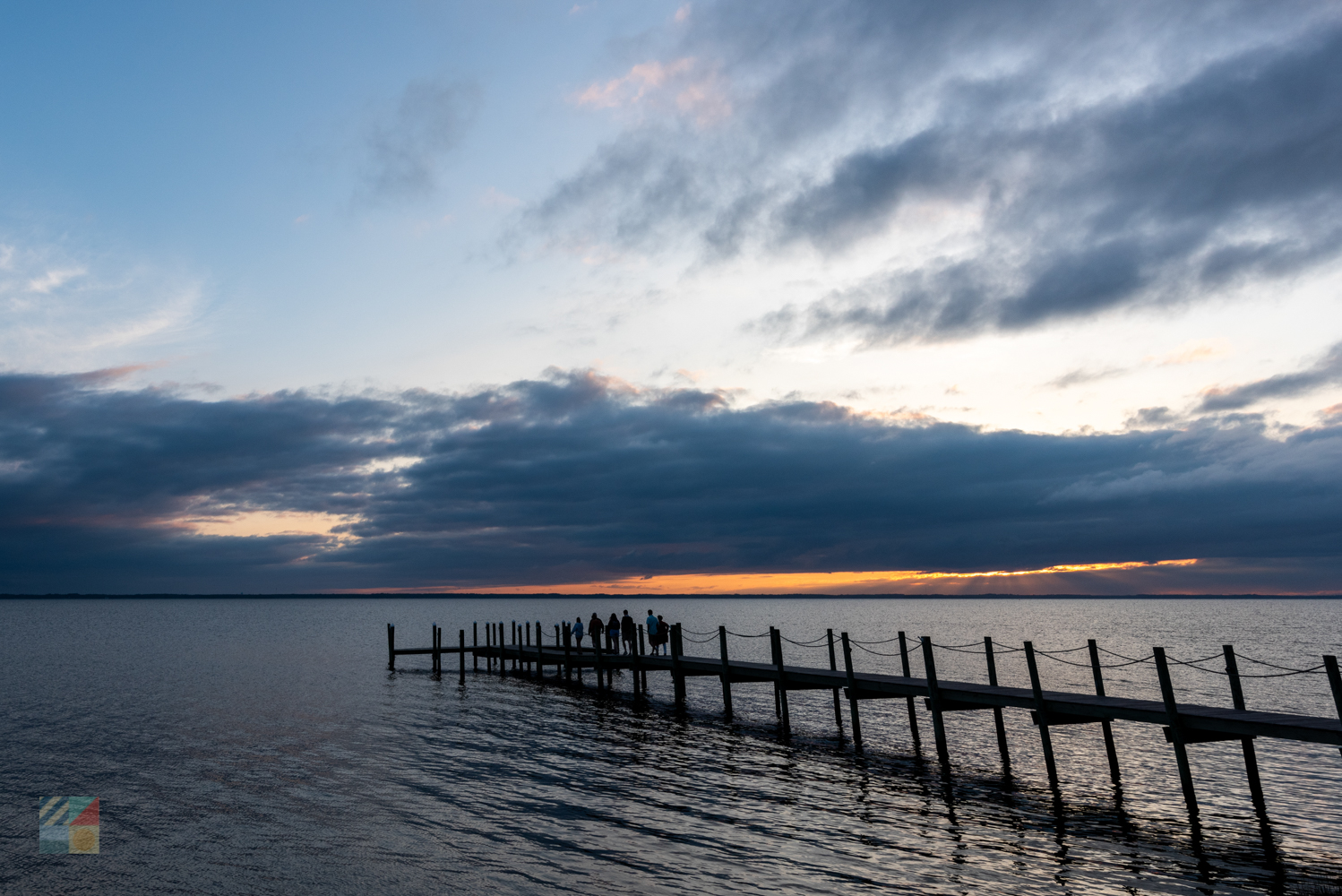
Visiting the Currituck Sound
There are a number of ways to explore the Currituck Sound, ranging from on-foot adventures to guided tours, and everything in between.
The best way to enjoy a sound visit is by heading to the northern Outer Banks' biggest attractions, specially the Whalehead in Historic Corolla and neighboring Currituck Beach Lighthouse, or the Duck Town Park. Both of these locales offer acres of land bordering the soundfront, as well as scenic nature trails ad boardwalks that lead visitors from the outskirts of the maritime forests to the very borders of the soundfront. Ideal for birders and folks who want a quick and gorgeously scenic tour of the sound, a walking trail through the Currituck beaches is an easy way to take in the beauty of the Currituck Sound with just a little bit of enjoyable effort.
Visitors who love a great outdoors adventure will be delighted to find that a number of watersports companies along the northern Outer Banks also offer scenic waterfront tours of the Currituck Sound. These adventures can take place in a number of mediums, from small boat tours to parasailing adventures, and launch regularly in season from the soundside shores of Duck or Corolla.

For a true natural exploration, book a kayak tour of the Currituck Sound, offered by a number of local watersports companies, including the regional chain Kitty Hawk Kites. This tour will take you deep into the open waters of the sound, bordering beautiful marshy islands, and featuring endless views of the open water and the wildlife that calls it home. Generally seasonal and lasting between 2-3 hours, a scenic nature tour through the Currituck Sound is an ideal way to explore these open waters for visitors of all ages.
For an adventure that's a little more thrilling, consider booking a soundside charter, available along the mainland, or simply take the boat out to the water via a number of public boat ramps available throughout the communities bordering the Currituck Sound. An open water exploration is an ideal way to explore the miles of water, islands, and brushy borders, and is also a great way to get to some of the most secretive and coveted fishing holes in between. Local businesses on both sides of the Currituck Sound, like Corolla Bait & Tackle, are happy to take visitors out on skiffs or pontoon boats to explore the waters, and find some of the best crabbing and fishing holes along the way.
Finally, visitors who want a panoramic view of the sound can hop aboard a vehicular ferry to Knotts Island. This island is essentially part residential community, and part nature reserve, and as a result offers some pristine and undisturbed views of the open waters. For a day trip that's simply relaxing and uncluttered, consider a trip to Knotts Island and Mackay Island National Wildlife Refuge. Completely wild and relatively undiscovered, a day trip to this region of the Outer Banks will be a truly wild and natural adventure.

Tips and Trips for Visiting the Currituck Sound
- If you're planning a day trip to Knotts Island, keep your eye on the summer and fall months. Knotts Island has a vineyard, gift shop, and even an annual peach festival, making it a fantastic day trip for in-season Outer Banks travelers. That being said, exploring the Mackay Island National Wildlife Refuge, which is located on Knotts Island, is a fun off-season adventure, as the marshy environment is free of mosquitos, and the temperate climate is perfect for avid hikers.
- If you're planning a guided boat or kayak tour during your Currituck Sound visit, be sure and book as far in advance as possible. The watersports companies that operate out of Duck and Corolla have a tendency to fill up quickly, especially in the busy months of June, July and August, when Outer Banks visitation is at its peak. Many watersports companies allow online reservations, or you can simply call ahead and see what Currituck Sound excursions are available during your upcoming vacation.
- For a completely free and completely scenic self-guided tour of the Currituck Sound, head to the reserves. Both the Currituck Banks Coastal Estuarine Reserve and the Currituck National Wildlife Refuge feature secluded nature trails that wind through the maritime forests towards the soundfront. Additional easier nature trails can be found by the Whalehead in Historic Corolla and the Duck Town Park, allowing visitors easy access to some of the most scenic waterfront sunsets on the northern Outer Banks.
- Speaking of waterfront sunsets, perhaps the best avenue for effortlessly enjoying the open waters of the Currituck Sound is via a round of cocktails or a five star meal at one of the northern Outer Banks' many waterfront restaurants. These establishments are located throughout Duck and Corolla, and may even offer dock-front seating for folks who want to be right on top of the water, or who are just pulling ashore on a boat for a quick bite. Ideal around sunset, a romantic Currituck Soundfront meal is the perfect way to spend a quiet and completely enjoyable evening during your vacation.
The Currituck Sound is a longstanding attraction to Outer Banks visitors, beginning with the adventurous elite vacationers who arrived in the early 20th century as part of a new generation of rustic hunt clubs. Today, the sound can be enjoyed by virtually everyone who makes a trip to the Currituck mainland or the northern Outer Banks, as the 30 mile expanse of water is easy to access from most any vantage point.

For a rustic waterfront tour through patches of marshy islands and shallow open waters, or a scenic nature trail that leads you to a wide open view of the Outer Banks' natural landscape at its best, plan a visit to the Currituck Sound. With miles of virtually unchartered territory to explore, the Currituck Sound is a North Carolina destination that is certainly on the map, but well off the beaten path.

-
Avon Farmers Market
July 15th, 2025 9:00 AM - 1:00 PM -
Mustang Mornings at the Farm
July 16th, 2025 10:00 AM - 2:00 PM -
Surfing For Autism
July 17th, 2025 - July 19th, 2025
Experience more adventure, fun, and style with Kitty Hawk Surf Company. As the trusted Outer Banks retailer for all top surf and lifestyle brands, including, Hurley, Billabong, RVCA, The North Face, Patagonia, Salt Life, Salty Crew, Volcom, O’Neill, Roxy, Ray-Ban, Oakley, Hobie, Catch Surf, Under Armour, Reef, Rainbow and more, you will always find the latest fashions and trends available in store. Our unmatched quality and service makes us a favorite for locals and visitors alike, and our easy to shop layout allows you to find your next purchase a breeze.
Sandy Run Park leads its visitors through the heart of Kitty Hawk Woods Coastal Preserve, one of the largest maritime forests remaining in North Carolina. Completed in two phases, the park now encompasses 1600 acres of marshland, waterways and maritime forest. The park features a wooden boardwalk, two gazebos, a fishing and many more amenities for the enjoyment of the area's natural beauty and wildlife. On a stroll through the park you will likely run into many of the area's indigenous creatures and plants.Just after entering the park, and next to the ample parking area you’ll find a covered picnic pavilion, a putting green, cookout grills and a basketball half court. Below the pavilion is a canoe and kayak access deck. Beyond this recreation and picnic area is a half-mile loop, mostly boardwalk, that will take you on a scenic and educational tour of a large section of the Preserve, where wildlife and plants are identified by plaques placed along the route. At the first gazebo stop is another kayak and canoe access where you’re sure to see many yellow-bellied slider turtles swimming all around and an Osprey family nesting above. Other creatures you may get a glimpse of include deer, otter, egrets, raccoons and even a nutria. Also along the boardwalk you’ll find an observation deck and a pier for fishing (license required). The fishing pond is stocked with several varieties of fish, including brim and bass..Sandy Run Park is open from sunrise to sunset. Although the cost is free, the natural serenity and beauty it offers is priceless.
Looking to fly a kite on the beach or atop the spectacular dunes of Jockey’s Ridge State Park? Kitty Hawk Kites offers the largest selection of kites, wind art, flags, games, and toys on the Outer Banks, with experts on staff to get you flying … or playing … in no time! Always dreamed of being a mermaid? Kitty Hawk Kites carries Fin Fun Mermaid Tails and also offers Mermaid Swim Lessons too! Kitty Hawk Kites also produces more than 20 events annually, including several kite festivals on the Outer Banks.
The Cape Hatteras Lighthouse, with its black and white candy-cane stripes, is one of the most famous and recognizable lighthouses in the world. Protecting one of the most treacherous stretches of the Outer Banks, with a beam of light that spans 20 miles into the ocean, the lighthouse is also the world's tallest brick lighthouse at a staggering 208' ft. tall.
Check out Corolla's newest 5-star attraction! Pirate-Themed 18-Hole Minature Golf Course and Arcade with waterfalls, a pirate ship, caves, skulls, and more! So much fun for the whole family! Come to Corolla Light's premier attraction located in Corolla Light Town Center. Your family will love this adventure!
Here is a list of some of our favorite beach toys for kiddos. We gravitate to unique, high-quality toys that inspire creativity. Some of these toys are classics, and some add a twist.
If you’re looking for a fun, hands-on activity that the whole family can enjoy together, hop aboard Risky Business for an Outer Banks shrimping and crabbing charter. Our experienced captain and mate will show your group how to pull crab pots to catch blue crabs and trawl for shrimp the same way that the local commercial fishermen do. You’ll learn about the species caught and how to sort through the catch – and everything of legal size is yours to keep for dinner! Along the way you’ll look for dolphins and other wildlife and see the sights in the Roanoke Sound and Croatan Sound. Based at Shallowbag Bay Marina in Manteo, our Outer Banks shrimping and crabbing charter is convenient to all the northern Outer Banks beach towns, only 5 minutes from Nags Head. We run charters in the summer only, from mid-June through September.
We love to highlight some of the best and most interesting Outer Banks restaurants, shops, attractions and activities. Read on to discover some of our favorites!
Discover the best homemade ice cream and authentic made-from-scratch New York Style pizza the Outer Banks has to offer at American Pie in Kill Devil Hills. An Outer Banks favorite for lunch, dinner or a delicious scoop of scrumptious ice cream after a day at the beach. It was 1978 when Eddie and Lou Miller first opened Miller’s Seafood and Steakhouse. As a teenager, their son Brian spent his summers working in the restaurant, getting familiar with the family business. After college, Brian and his wife Beth came back to Kill Devil Hills and began working together at Miller’s. Brian and Beth officially purchased the restaurant from Eddie and Lou in 2007. A few years later they opened American Pie together, and both restaurants now carry on the Miller family tradition of quality, excellence and hospitality. “I learned everything about the restaurant business from my parents,” Miller says. “They ran the business together for all those years, and now my wife and I are doing the same. “Throughout the summer, we’re feeding around 2,000 people a day in our two restaurants. It’s a challenge we embrace every season, and we get a lot of fulfillment from making it all work.” The Millers focus on two main specialties: high quality foods and unparalleled service. Seafood at Miller’s is fresh and locally caught, and they serve high-quality Angus beef, fresh pastas and homemade desserts. At American Pie, guests enjoy hand-tossed pizzas and homemade ice cream. “We put a lot of time and effort into ensuring the products we bring in are top-notch,” Miller says. “Our customers know that when they visit our restaurants, they’ll be getting the quality and consistency they’ve come to know and love.”
Seasoned visitors to Ocracoke Island love to soak in its rich heritage and culture which dates back to the 1500s, and features some legendary and longstanding residents. Some of the most popular Ocracoke locals are the Wild Ponies, which are protected in a secluded 180 acre area enclosure on the soundside of the Cape Hatteras National Seashore, but can still be enjoyed by anyone passing through the island on NC Highway 12.
Miller's Seafood & Steakhouse has been a favorite among locals and visitors for more forty years. Offering delicious southern cuisine for both breakfast and dinner in a casual family atmosphere infused with coastal flair, it's no wonder this Kill Devil Hills restaurant is a family tradition for so many. You'll love waking up to favorites like biscuits and gravy, farm fresh eggs and buttermilk pancakes.
Beach canopies and umbrellas create shade, lower ambient temperatures and block UV rays on hot, sunny Summer days. Sitting under the canopy of a quality beach umbrella can make the difference between comfort and sweltering. When choosing an umbrella, we look for durability, wind ratings, weight and size.
Discover wild Spanish Mustangs and our unique Barrier Island ecology on the Wild Horse Safari. Explore over 30 miles of "off road" beach, dune and sand trail and ride with a professional naturalist guide in a custom 4x4 open-air Safari Cruiser, or experience the Beach Cruiser and Kayak Safari combination tour to paddle in the placid waterways of the wildlife rich Currituck Sound. The Outer Banks Leader in off road Eco-Adventures! Where the Road Ends....The Adventure Begins.
The Ocracoke Island Lighthouse may not be the most imposing of the Outer Banks lighthouses, but as North Carolina's oldest lighthouse in operation, (and the second oldest in the United States), it is certainly one of the most beloved. At just 65' ft. tall, it is by far the smallest lighthouse on the Outer Banks, but it still towers over the 4 square miles of Ocracoke Village, and its beacon can be spotted up to 14 miles into the Pamlico Sound and the Atlantic Ocean.
